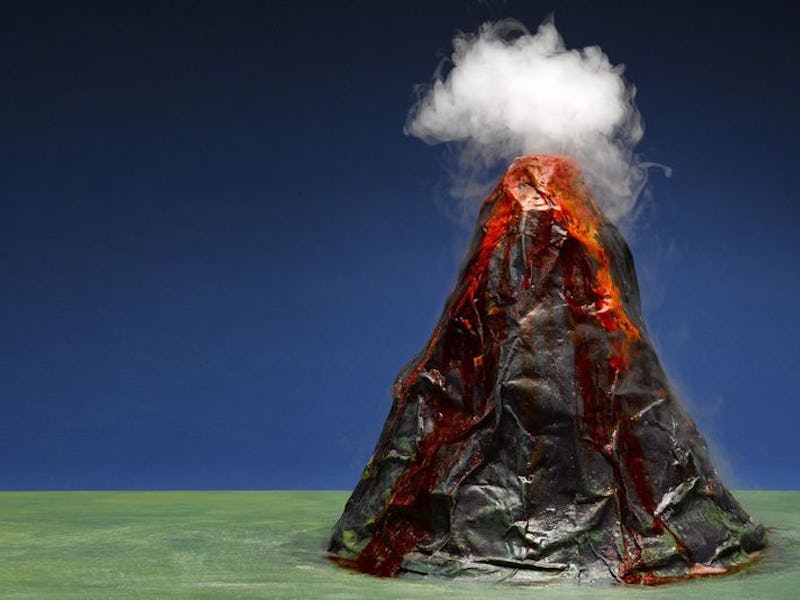The Revival of Dope at-Home Science Experiments
Journalist Rebecca Onion traces the rise of science fairs in her new book, 'Innocent Experiments'.

Science fair experiments might remind you of your awkward clay volcano project in fourth grade, or trying to string together some toothpicks with sticky glue. It wasn’t pretty, but admit it — making a gigantic mess and seeing mini-explosions or balancing stuff was pretty cool.
Journalist and historian Rebecca Onion gets it. Her recently released book, Innocent Experiments: Childhood and the Culture of Public Science in the United States, explains the rise of at-home science experiments in the twentieth century, and what they mean in a world where the acknowledgment of science has become politicized and fraught. Inverse spoke to Onion by phone.
These at-home experiments seem so familiar to us now, almost cute and normalized. But when exactly did they begin to take off?
The first chemistry sets in the U.S. were sold in the 1910s, right before World War I. And even before that, there was a 19th-century genre of science books for kids, like home entertainment manuals a parent might buy to give a kid something to do. [These were] marketed as parlor science books, stuff you could do with candles or other things you have in your house already.
Then in the inter-war years, there were a few companies selling chemistry sets. The [A. C.] Gilbert Company, the Porter [Chemical] Company, they marketed to a range of kids with starter sets for younger kids, and then for high-schoolers who might be serious about chemistry, too.
There was more of a mystique during World War II. Concerns about national defense — do we have as many science-minded kids as other countries — once Sputnik went up in 1957, that catalyzed a lot.
Did these anxieties really not exist at all before Sputnik? Or do we just remember it that way?
Before I researched all this, I thought I’d see a 1957 explosion — which is sort of the case in terms of the way science education was conceptualized and thought about. But when you look at toys, there was already a lot of marketing before.
Speaking of marketing, we’re much more conscious today of how harmful gendered products can be. How were these sets marketed at the time?
They were definitely gendered toward boys. A lot of nostalgia now is tied to the idea that boys were using all these different experiments and now we’re just way too worried for their safety. When we talk about chemistry sets from the past, we say children should still be able to do this or this, but what we’re really thinking about is boys. The Gilbert Company, which folded in [the 1960s], their slogan was “Hello Boys.”
There was still a science manpower crisis the government was worried about; they produced a lab technician set with pink on the front.
How do you feel about current marketing efforts like GoldieBlox?
I don’t know. It’s hard, because on the one hand, ideally, I’d love [more girls involved]. If you look at science sets made now, there are science sets that are pink for the girls, and I don’t think GoldieBlox is quite that bad; there’s some stuff that’s definitely, explicitly tied to ideas about girlishness and that has very deep roots. It traffics in ideas of aesthetics or domesticity, saying that boys are interested in the larger world, or grossness, or blood, or bugs, it speaks to a classic boyishness. That conventional set of appeals, I find that stuff more upsetting than just pink or blue.
We’re in this time now when people are getting different facts and science is just not being believed. Do you think science will have an increased or decreased presence in pop culture going forward?
I think there’s still a strong conventional wisdom or ideology, a strong hope that people will continue to be interested in science and excited about science, though maybe that’s a liberal filter bubble. You read sad commentaries about the demise of chemistry sets or home experimentation … as a historian, we have a tendency to look back on the 50s as a golden age. But there were a number of scientists at the time who would look at things framed as so exciting, in terms of getting kids involved in science, and would still say, ‘I don’t know if all these home experiments are teaching the scientific method.’ [They’d question] if they were actually valid from an academic standpoint. If you look at some of the instruction booklets, some of them are ridiculous. Like, here’s an experiment, if you feel sick, eat a bunch of good-for-you foods like salmon and vegetable and see if you feel better.
The future of at-home sets is probably going to have to happen more outside of school. School curricula are more consolidated and standardized … people want kids to be motivated to do this stuff, but, you know, the science fair is kind of a sham, and there’s too much pressure. People in the twentieth century thought school science was crap, too. People always make that critique, so it’s hard to say whether it was better then or now. It’s hard to say when a kid is going to spark or get excited at something. You give one kid a chemistry set and they’re bored; you give it to another, they’re excited.
This interview has been edited for clarity and brevity.